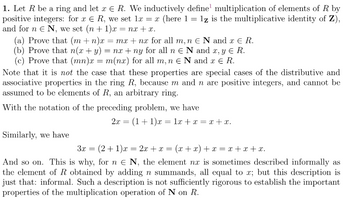
Advanced Engineering Mathematics
10th Edition
ISBN: 9780470458365
Author: Erwin Kreyszig
Publisher: Wiley, John & Sons, Incorporated
expand_more
expand_more
format_list_bulleted
Question
1

Transcribed Image Text:1. Let R be a ring and let x € R. We inductively define multiplication of elements of R by
positive integers: for x ER, we set 1x = x (here 1 = 1z is the multiplicative identity of Z),
and for n € N, we set (n+1)x= nx+x.
=
(a) Prove that (m + n)x = mx + nx for all m, n E N and x € R.
(b) Prove that n(x + y) = nx + ny for all n N and x, y € R.
(c) Prove that (mn)x= m(nx) for all m, n E N and x € R.
Note that it is not the case that these properties are special cases of the distributive and
associative properties in the ring R, because m and n are positive integers, and cannot be
assumed to be elements of R, an arbitrary ring.
With the notation of the preceding problem, we have
Similarly, we have
2x = (1+1)x= 1x + x = x+x.
3x =
= (2+1)x = 2x + x = (x+x) + x = x+x+x.
And so on. This is why, for n € N, the element nx is sometimes described informally as
the element of R obtained by adding n summands, all equal to x; but this description is
just that: informal. Such a description is not sufficiently rigorous to establish the important
properties of the multiplication operation of N on R.
Expert Solution
This question has been solved!
Explore an expertly crafted, step-by-step solution for a thorough understanding of key concepts.
Step by stepSolved in 3 steps with 2 images

Knowledge Booster
Similar questions
arrow_back_ios
arrow_forward_ios
Recommended textbooks for you
 Advanced Engineering MathematicsAdvanced MathISBN:9780470458365Author:Erwin KreyszigPublisher:Wiley, John & Sons, Incorporated
Advanced Engineering MathematicsAdvanced MathISBN:9780470458365Author:Erwin KreyszigPublisher:Wiley, John & Sons, Incorporated Numerical Methods for EngineersAdvanced MathISBN:9780073397924Author:Steven C. Chapra Dr., Raymond P. CanalePublisher:McGraw-Hill Education
Numerical Methods for EngineersAdvanced MathISBN:9780073397924Author:Steven C. Chapra Dr., Raymond P. CanalePublisher:McGraw-Hill Education Introductory Mathematics for Engineering Applicat...Advanced MathISBN:9781118141809Author:Nathan KlingbeilPublisher:WILEY
Introductory Mathematics for Engineering Applicat...Advanced MathISBN:9781118141809Author:Nathan KlingbeilPublisher:WILEY Mathematics For Machine TechnologyAdvanced MathISBN:9781337798310Author:Peterson, John.Publisher:Cengage Learning,
Mathematics For Machine TechnologyAdvanced MathISBN:9781337798310Author:Peterson, John.Publisher:Cengage Learning,


Advanced Engineering Mathematics
Advanced Math
ISBN:9780470458365
Author:Erwin Kreyszig
Publisher:Wiley, John & Sons, Incorporated

Numerical Methods for Engineers
Advanced Math
ISBN:9780073397924
Author:Steven C. Chapra Dr., Raymond P. Canale
Publisher:McGraw-Hill Education

Introductory Mathematics for Engineering Applicat...
Advanced Math
ISBN:9781118141809
Author:Nathan Klingbeil
Publisher:WILEY

Mathematics For Machine Technology
Advanced Math
ISBN:9781337798310
Author:Peterson, John.
Publisher:Cengage Learning,

